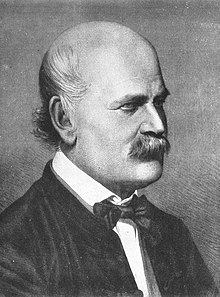
The idea of washing hands to prevent the spread of disease is not a new one. You might be surprised to learn that the idea was developed in 1847 by Ignaz Philipp Semmelweis, a Hungarian doctor and scientist, who discovered a link between disease and washing hands before the idea of germs and microorganisms were understood.
Semmelweis discovered that having physicians wash their hands reduced the maternal morality rate of women after childbirth. He compared the death rates caused by puerperal fever at two different clinics. He discovered that the rate was higher at the clinic where medical students were doing autopsies before seeing patients. He theorized that something from the corpses was infecting the patients seen by the medical students who had conducted autopsies.
At that time, germs were not understood or even recognized as a cause of disease. Semmelweis had no idea what a germ was, but he discovered that getting doctors to wash their hands after autopsies reduced the spread of puerperal fever and the overall morality rate. He was able to bring down the mortality rate of the clinic with the highest death rates by 90%, and bring down the overall death rate in both clinics from 10% to 1% or less by implementing hand washing procedures.
Unfortunately, Semmelweis findings were rejected by the medical community because they said that he did not have a scientific explanation for why hand washing made a difference. Semmelweis had the data to show washing hands worked, but without a valid theory explaining germs and how they spread disease, his discovery was dismissed.
Semmelweis died a tragic death. In 1865, two weeks after being committed to a psychiatric hospital by his peers, he died from an infected wound from a struggle with hospital guards.
It was not until after Semmelweis’ death and the acceptance of Louis Pasteur’s work with germ theory, that the practice of washing hands was accepted by the medical community. Louis Pasteur discovered that microorganisms cause disease and fermentation. He developed some of the first vaccines, and what we know as the pasteurization process. Pasteur patented the pasteurization process in 1865. The same year that Semmelweis died.
Center for Disease Control’s When and How to Wash Your Hands
The Center for Disease Control and Prevention (CDC) emphasizes “During the Coronavirus Disease (COVID-19) pandemic, keeping hands clean is especially important to help prevent the virus from spreading.”
CDC’s Key Times to Wash Hands
- Before, during, and after preparing food
- Before eating food
- Before and after caring for someone at home who is sick with vomiting or diarrhea
- Before and after treating a cut or wound
- After using the toilet
- After changing diapers or cleaning up a child who has used the toilet
- After blowing your nose, coughing, or sneezing
- After touching an animal, animal feed, or animal waste
- After handling pet food or pet treats
- After touching garbage
During the COVID-19 pandemic, you should also clean hands:
- After you have been in a public place and touched an item or surface that may be frequently touched by other people, such as door handles, tables, gas pumps, shopping carts, or electronic cashier registers/screens, etc.
- Before touching your eyes, nose, or mouth because that’s how germs enter our bodies.
